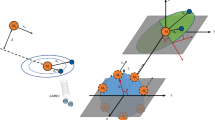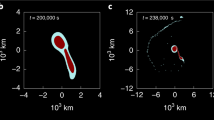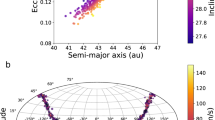Abstract
Triton is Neptune's principal satellite and is by far the largest retrograde satellite in the Solar System (its mass is ∼40 per cent greater than that of Pluto). Its inclined and circular orbit lies between a group of small inner prograde satellites and a number of exterior irregular satellites with both prograde and retrograde orbits. This unusual configuration has led to the belief that Triton originally orbited the Sun before being captured in orbit around Neptune1,2,3. Existing models4,5,6 for its capture, however, all have significant bottlenecks that make their effectiveness doubtful. Here we report that a three-body gravitational encounter between a binary system (of ∼103-kilometre-sized bodies) and Neptune is a far more likely explanation for Triton's capture. Our model predicts that Triton was once a member of a binary with a range of plausible characteristics, including ones similar to the Pluto–Charon pair.
This is a preview of subscription content, access via your institution
Access options
Subscribe to this journal
Receive 51 print issues and online access
$199.00 per year
only $3.90 per issue
Buy this article
- Purchase on Springer Link
- Instant access to full article PDF
Prices may be subject to local taxes which are calculated during checkout




Similar content being viewed by others
References
McCord, T. B. Dynamical evolution of the Neptunian system. Astron. J. 71, 585–590 (1966)
McKinnon, W. B. On the origin of Triton and Pluto. Nature 311, 355–358 (1984)
McKinnon, W. B., Lunine, J. I. & Banfield, D. Neptune and Triton (ed. Cruikshank, D. P.) 807–877 (Univ. Arizona Press, Tucson, 1995)
Pollack, J. B., Burns, J. A. & Tauber, M. E. Gas drag in primordial circumplanetary envelopes—A mechanism for satellite capture. Icarus 37, 587–611 (1979)
McKinnon, W. B. & Leith, A. C. Gas drag and the orbital evolution of a captured Triton. Icarus 118, 392–413 (1995)
Goldreich, P., Murray, N., Longaretti, P. Y. & Banfield, D. Neptune's story. Science 245, 500–504 (1989)
Heggie, D. C. Binary evolution in stellar dynamics. Mon. Not. R. Astron. Soc. 173, 729–787 (1975)
Hills, J. G. Computer simulations of encounters between massive black holes and binaries. Astron. J. 102, 704–715 (1991)
Funato, Y., Makino, J., Hut, P., Kokubo, E. & Kinoshita, D. The formation of Kuiper-belt binaries through exchange reactions. Nature 427, 518–520 (2004)
Morbidelli, A. & Levison, H. F. Scenarios for the origin of the orbits of the trans-neptunian objects 2000 CR105 and 2003 VB12 (Sedna). Astron. J. 128, 2564–2576 (2004)
Tsui, K. H. Satellite capture in a four-body system. Planet. Space Sci. 50, 269–276 (2002)
Durda, D. D. et al. The formation of asteroid satellites in large impacts: results from numerical simulations. Icarus 170, 243–257 (2004)
Weidenschilling, S. J. On the origin of binary transneptunian objects. Icarus 160, 212–215 (2002)
Goldreich, P., Lithwick, Y. & Sari, R. Formation of Kuiper-belt binaries by dynamical friction and three-body encounters. Nature 420, 643–646 (2002)
Astakhov, S. A., Lee, E. A. & Farrelly, D. Formation of Kuiper-belt binaries through multiple chaotic scattering encounters with low-mass intrudes. Mon. Not. R. Astron. Soc. 360, 401–415 (2005)
Canup, R. M. A giant impact origin of Pluto-Charon. Science 307, 546–550 (2005)
Margot, J. L. et al. Binary asteroids in the near-earth object population. Science 296, 1445–1448 (2002)
Merline, W. J. et al. Asteroids III (eds Bottke, W. F. Jr, Cellino, A., Paolicchi, P. & Binzel, R. P.) 289–312 (Univ. Arizona Press, Tucson, 2002)
Stephens, D. C. & Noll, K. S. Detection of six trans-neptunian binaries with NICMOS: A high fraction of binaries in the cold classical disk. Astron. J. 131, 1142–1148 (2006)
Hamilton, D. P. & Burns, J. A. Orbital stability zones about asteroids. II—The destabilizing effects of eccentric orbits and of solar radiation. Icarus 96, 43–64 (1992)
Asphaug, E. & Benz, W. Size density, and structure of comet Shoemaker-Levy 9 inferred from the physics of tidal breakup. Icarus 121, 225–248 (1996)
Ćuk, M. & Gladman, B. J. Constraints on the orbital evolution of Triton. Astrophys. J. 626, L113–L116 (2005)
Hamilton, D. P., Zhang, K. & Agnor, C. B. Constraints on Triton's orbital evolution. AAS/Div. Dyn. Astron. Meet. 36(2), 11.04 (2005)
Goldreich, P. & Soter, S. Q in the Solar System. Icarus 5, 375–389 (1966)
Benner, L. A. M. & McKinnon, W. B. Orbital behaviour of captured satellites: The effect of solar gravity on Triton's postcapture orbit. Icarus 114, 1–20 (1995)
Lissauer, J. J., Pollack, J. B., Wetherill, G. W. & Stevenson, D. J. Neptune and Triton (ed. Cruikshank, D. P.) 37–108 (Univ. Arizona Press, Tucson, 1995)
Hahn, J. M. & Malhotra, R. Orbital evolution of planets embedded in a planetesimal disk. Astron. J. 117, 3041–3053 (1999)
Gomes, R. S., Morbidelli, A. & Levison, H. F. Planetary migration in a planetesimal disk: why did Neptune stop at 30 AU? Icarus 170, 492–507 (2004)
Ward, W. R., Agnor, C. B. & Tanaka, H. in Astrophysical Ages and Time Scales (eds von Hippel, T., Simpson, C. & Manset, N.) 111–120 (ASP Conf. Ser. 245, Astronomical Society of the Pacific, San Francisco, 2001)
Goldreich, P., Lithwick, Y. & Sari, R. Planet formation by coagulation: a focus on Uranus and Neptune. Annu. Rev. Astron. Astrophys. 42, 549–601 (2004)
Acknowledgements
We thank E. Asphaug for advice and support and C. McGleam for a critical reading of the manuscript. This work was supported by the National Aeronautics and Space Administration under grants issued through the Planetary Geology and Geophysics, Outer Planets Research, and Origins of Solar Systems programmes.
Author information
Authors and Affiliations
Corresponding author
Ethics declarations
Competing interests
Reprints and permissions information is available at npg.nature.com/reprintsandpermissions. The authors declare no competing financial interests.
Rights and permissions
About this article
Cite this article
Agnor, C., Hamilton, D. Neptune's capture of its moon Triton in a binary–planet gravitational encounter. Nature 441, 192–194 (2006). https://doi.org/10.1038/nature04792
Received:
Accepted:
Issue Date:
DOI: https://doi.org/10.1038/nature04792
This article is cited by
-
The formation of Haumea and its family via binary merging
Nature Communications (2022)
-
Large planets may not form fractionally large moons
Nature Communications (2022)
-
Science Goals and Mission Objectives for the Future Exploration of Ice Giants Systems: A Horizon 2061 Perspective
Space Science Reviews (2021)
-
Uranian satellite formation by evolution of a water vapour disk generated by a giant impact
Nature Astronomy (2020)
-
Evidence for very early migration of the Solar System planets from the Patroclus–Menoetius binary Jupiter Trojan
Nature Astronomy (2018)
Comments
By submitting a comment you agree to abide by our Terms and Community Guidelines. If you find something abusive or that does not comply with our terms or guidelines please flag it as inappropriate.



